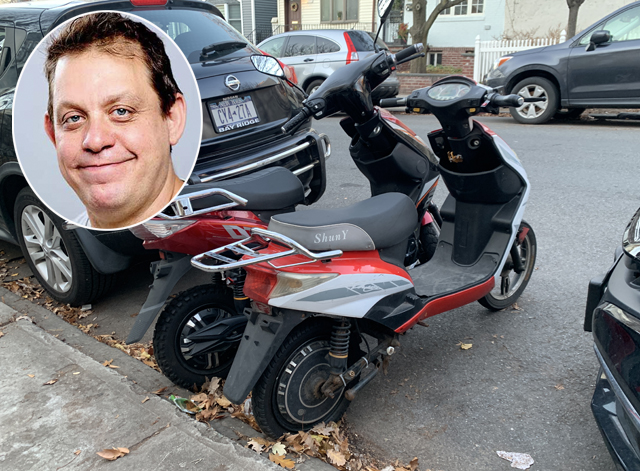Opinion: E-Bike Charging Stations in Former Newstands Won’t Get it Done
12:01 AM EDT on October 11, 2022

Mayor Adams’s recent announcement that the city would repurpose an abandoned newsstand into an e-bike charging station (with more on the way) is a plan that’s fraught with liability, uses public space poorly, helps very few people and, worse, doesn’t solve the problem of charging and storing dangerous batteries in too many buildings.
Nobody knows how many e-bikes and e-scooters there are in New York City. Advocates say there are 65,000 delivery workers alone, most using electric bikes or mopeds, but that figure is dated; the actual number of e-bike users is likely much higher, given that e-bike growth in 2021 was 240 percent.

Electric bike use has exploded since they were officially legalized in 2020, so everyone needs a charging solution. (Even Citi Bike, whose electric two-wheelers are so popular that racks are full of e-bikes that are out of service because they are waiting for their batteries to be swapped out.)
E-bikes, e-scooters and electric mopeds are the fastest-spreading mode of transportation for utility and leisure in urban environments, and with the spread of cargo e-bikes, we are finally on the path to replacing the personal car with something more sustainable for the city.
Unfortunately, the city is waking up to the fact that we lack the proper infrastructure and regulation for managing this growth.
Just as with car drivers, the city has had a hard time cracking down on these unregistered, ambiguously defined vehicles whose drivers often traffic laws, nor does the city do anything about e-moped shops that simply sell an illegal product and dupe the uninformed. There are battery fires in apartments, houses, bike shops, garbage trucks and garbage barges. NYCHA is calling for an all-out ban on e-bikes and e-bike batteries in their properties, the FDNY doesn’t let them into any of their facilities, many pedestrians hate them, and many private landlords in the city are prohibiting them in their buildings.
The mayor’s press conference, which was really more of an improv session than a plan, touched on none of that. It provided no bold vision of getting more people out of cars and onto micro-mobility devices, barely considered public safety besides referencing safety codes that don’t exist yet or aren’t enforced, and was ambiguous about the specific technical details of these charging stations, or even who could qualify to use these charging ports if they actually get built.
Delivery riders are my heroes. They fed us during the pandemic, kept the city’s restaurants alive, and ride in every weather condition for low wages. However, giving app-delivery riders the exclusive use of public e-bike charging stations isn’t a gift to riders, it’s a subsidy rewarding the unfair labor practices of the delivery apps and their Silicon Valley billionaire overlords. These liberterian billionaires could easily set up charging stations as an incentive for their full time, seven-day-a-week, “gig-workers,” but they choose not to since they are simply interested in externalizing labor, liability and workplace safety costs to anyone outside of themselves.
Most batteries and chargers are black boxes: no one knows who built them, no one knows how they got here, no one knows how long they’ve been in service, and no one tracks what happens to them when they reach end of life. There is zero accountability. The Doordash/GrubHub/UberEats tech bros business model is basically, “Burning Man for me, burning apartments for thee.”
Almost daily the FDNY tweets a reminder that batteries must always be charged with the manufacturers’ recommended chargers, which would be an impossibility at a public charging hub. The alternative, where people bring their own Alibaba chargers to the stations, is even worse, both for the riders who then have to carry a charger everywhere, and for the stations who would have no quality control of what is being plugged into their outlets.
If using a lithium-ion battery, follow the manufacturer’s instructions for charging and storage. Always use the manufacturer’s cord and power adapter made specifically for the device. If a battery overheats, discontinue use immediately. See more at https://t.co/NpwdRdlElY pic.twitter.com/I6ALnGgtwb
— FDNY (@FDNY) October 6, 2022
No rider wants to wait around for three hours for their bike to charge instead of picking orders for deliveries. Delivery workers usually carry a second battery or pay $50/month to dangerously charge a second battery in a friendly restaurant or bike shop.
My company, Popwheels, is building a far safer, more sustainable, and more efficient alternative to the current situation. We think the future in New York City is not private battery charging in people’s apartments, but battery swapping from charging cabinets. That’s what they do in Taiwan and India, and that’s what we should be doing here. Think of us like Citi Bike, but customers own their own bike, they just use our batteries, which they can swap out at any of our cabinets. He hope to have 4,000 cabinets soon.
We are also changing the electrochemistry in the battery packs from unsustainably- or unethically-mined nickel cobalt to Lithium iron phosphate cells to make them less likely to explode, adding two heat-triggered fire extinguishers inside the battery, and add geo-fencing and remote monitoring so our packs are safer in apartments and for pedestrians.
This is the bold plan the city needs — a plan that isn’t a subsidy for the billionaire owners of delivery apps, and will increase overall micro-mobility adoption, reduce car ownership, and make the city safer for pedestrians, riders and apartment dwellers. It will provide accountability where there currently is none.
So stop wasting our time Mayor Adams. Get real stuff done.
Baruch Herzfeld is the founder of Popwheels. He is not affiliated with Streetsblog nor does Streetsblog or Open Plans (its parent company) have any interest, commercial or otherwise, in Popwheels. This story is presented simply as proposal for solving a complex issue.
Read More:
Stay in touch
Sign up for our free newsletter
More from Streetsblog New York City
Report: Road Violence Hits Record in First Quarter of 2024
Sixty people died in the first three months of the year, 50 percent more than the first quarter of 2018, which was the safest opening three months of any Vision Zero year.
Street Sweepers Could Nab Illegal Parking Under State Bill
Smile for the street-sweeper!
Thursday’s Headlines: The Way of Water Edition
The "Blue Highways" campaign wants the mayor to convert a downtown heliport into a freight delivery hub. Plus more news.
Gotcha-Heimer! Anti-Congestion Pricing Jersey Rep. With a City Speeding Ticket Drove to Manhattan on Wednesday
New Jersey's most vociferous opponent of congestion pricing parked illegally and once got a speeding ticket.




